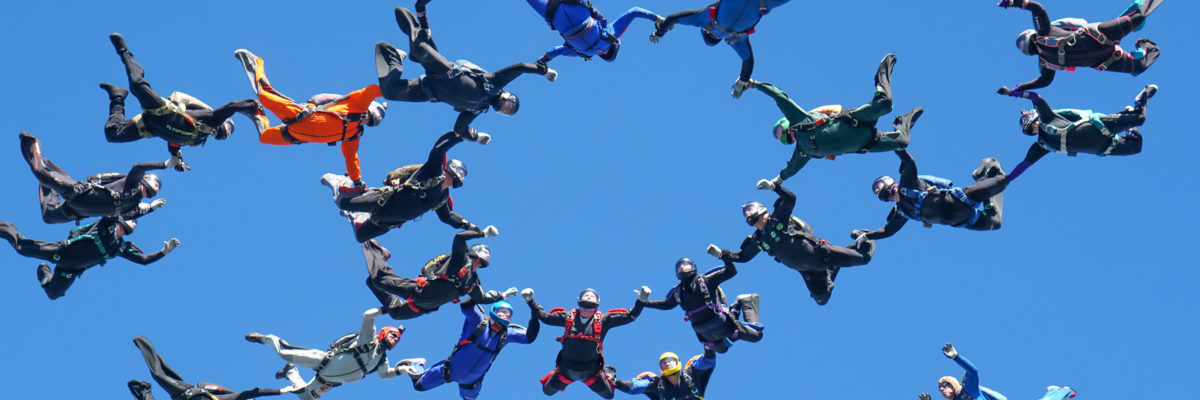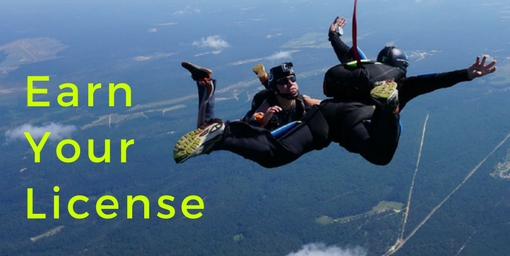
Skydiving Freefall: What To Expect
Wednesday, August 26, 2020
- Team FlyXP
- 8/26/20
- 0
- Tandem Skydiving
Many think that freefalling from 14,000 feet at 120 miles per hour could be the best thing ever or worst nightmare come true. It’s not your worst nightmare, but if you’ve never done it, the thought of free falling seems downright crazy! In this article, we’re going to unpack every aspect of the skydiving freefall experience to help give you peace of mind and clarity with what to expect when you participate in a tandem skydive at Skydive Paraclete XP.
Is Freefall Scary?
If you’re thinking about freefall, then you’re probably thinking that your insides are going to rocket up from your stomach directly into your throat just as it does on a rollercoaster. Good news: nope, that won’t happen in skydiving. Unlike a roller coaster, that “sick” feeling doesn’t happen for most people, and for the few who do feel it, it’s generally for less than two seconds.
Freefall isn’t that scary, and the reason is because you don’t ever feel like you’re falling. It’s the opposite of what you think it is! Here are a few insights about free fall that will likely surprise you
- You’ll have no idea that you’re falling at 120 miles per hour
- You won’t feel like you’re falling uncontrollably out of the sky
- You won’t experience ground rush
- You won’t feel like you’re out of control!
- You won’t want to throw up (unless you don’t eat, or eat a lot, pre-jump)
Because of all this, freefall isn’t scary at all. That’s why you see everyone smiling in nearly every photo — it’s a wonderful sensation!

What Does Freefall Feel Like?
We’ve shared what freefall doesn’t feel like, so here we’ll try to explain the impossible: what it actually feels like. It’s hard to explain the sensation of freefall in words because freefall feels like … freefall! It doesn’t feel like anything else, but here’s our best attempt at translating the feeling:
Imagine laying face-first down on a Tempur-Pedic mattress with a strong breeze blowing in your face. When freefalling, you’ll feel a positive pressure below you much like you would when laying on your favorite foam mattress. The wind sounds pretty off-putting, but you’ll be wearing goggles and it won’t leave you feeling overwhelmed. Of course, laying on a mattress won’t ever simulate the incredible rush of adrenaline that you’ll be feeling as you descend.
Free Fall FAQs
How long does freefall last?
Time spent in freefall is dependent upon exit altitude and the deployment altitude of the parachute. At Skydive Paraclete XP, tandem skydiving is conducted from an exit altitude of 13,500 feet and a deployment altitude between 5,000 and 5,500 feet. This leads to approximately 55 seconds of freefall.
Usually, freefall takes 10 seconds to descend the first 1,000 feet (as you build speed after you leave the plane) and six seconds for every additional 1,000 feet of descent.
What is Accelerated Freefall?
Accelerated freefall is a common type of training program used to train new jumpers to become licensed skydivers. At Skydive Paraclete XP, we’ve modified this training program to include wind tunnel training (an amazing training tool used by the best skydivers in the world). Our training program is known as PSP – Paraclete Student Program.
How Does Indoor Skydiving Help with Freefall
Indoor skydiving has revolutionized the sport of skydiving because it allows skydivers to train in similar conditions to real skydiving freefall without the need for an aircraft or a parachute.
Skydivers manipulate the wind on their bodies to execute technical maneuvers, and the use of a wind tunnel fine tunes these body positions because of the ability to receive immediate feedback and the opportunity to get more “air time” — which causes the learning curve to skyrocket.
The world’s elite military teams and civilian competition skydiving teams all use a wind tunnel as part of their training regimen. Skydive Paraclete XP’s sister operation is Paraclete XP – the largest indoor skydiving wind tunnel in the United States. We’re proud to offer this tool to our new skydivers as well as the general public wishing to do something unique as a family!
The wind tunnel is also a great training tool for those who have a lot of anxiety with the concept of making a tandem skydive or entering the learn to skydive program.
Have questions? We’d love to hear from you! Feel free to contact us or call us at (910) 904-0000.
Related Articles
- The Proper Body Position for Exiting the Aircraft and Free Fall
- How Long Does a Skydive Last?
- How High Are Skydiving Jumps?
- First Time Skydiving – What You Don’t Expect
- How Risky is Skydiving?
- What Goes Through Your Mind When You’re Skydiving?
- Five Questions Every New Skydiver Should Be Asking
- Top 7 Mistakes First Time Skydivers Make (and How to Avoid Them)
- How to Prep Days In Advance for a Skydive
Copyright © 2024, Skydive Paraclete XP, All Rights Reserved.
DropZone Web Design & Marketing by Beyond Marketing, LLC
